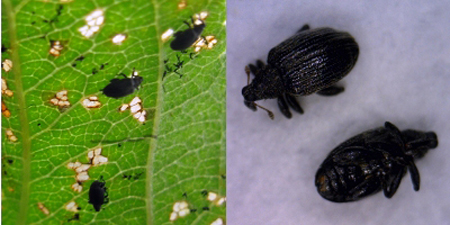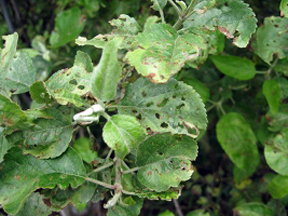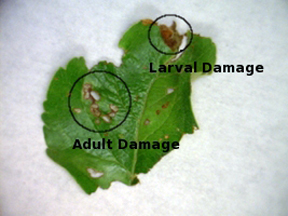Emerging pest alert: The apple flea weevil
Over that last several years the apple flea weevil (Orchestes pallicornis) (Photo 1) has become an increasingly common pest in Michigan apple orchards.
Editor’s note: This article is from the archives of the MSU Crop Advisory Team Alerts. Check the label of any pesticide referenced to ensure your use is included.
Over that last several years the apple flea weevil (Orchestes pallicornis) (Photo 1) has become an increasingly common pest in Michigan apple orchards. It has primarily been found in organic orchards, but damage has also been observed in at least two conventional orchards. At low populations the weevil likely goes unnoticed, but at high populations it is capable of causing total crop loss. Two organic farms in the Southwestern region as well as the organic block at the MSU Clarksville research station have reported a 90 percent or worse crop loss this year.
The apple flea weevil emerges in the early spring between the green tip and pink stages of apple bud development. Adults feed on leaves and buds leaving characteristic “shot hole” type damage (Photos 1-3). Adults lay eggs in the leaves and larvae develop as leaf miners, typically feeding from the middle of the leaf to the edge. Larvae pupate within a pupal chamber formed between the two leaf surfaces (Photo 3) and emerge in June and July. Newly emerged Adults feed on leaf tissue before entering diapause in late August or September. Previous literature states that adults overwinter at the base of trees.
Identification of damage due to this pest has been delayed in part because damage is often misdiagnosed as either frost damage and sulfur or other phytotoxicity. Feeding by adults prior to fruit set causes buds and blossoms to abort while larval feeding causes brown patches on leaf margins that resemble sulfur damage. Adult damage further mimics frost damage because beetles begin feeding at the base of trees and work their way up to the top. Management of this pest will depend on preventing adults from feeding on young foliage and buds, most likely through the application of adulticides.
The apple flea weevil is a largely unresearched pest. Previous out outbreaks of the weevil include one in the early 1980’s and a severe outbreak in the late 1920’s. The most recent scientific publication on the weevil is from 1951. From old records it appears that adult weevils are long lived (up to 48 days post diapause) and have a single generation per year. Larval development appears to be completed over 2-3 weeks.
“Old time” pest management recommendations (e.g. arsenate of lead, DDT) are largely inappropriate for conventional or organic management. Conventional preblossom applications of Lorsban® or Guthion® at greentip or pink stages likely provide management in conventional orchards. The upcoming phase out of Guthion®, recent loss of EndoSulfan® and high potential for the loss of Lorsban® should make researching pest management alternatives for this emerging pest a priority. Currently, no proven options for organic management are available although it is likely that the beetle will be susceptible to natural pyrethrums. Also, there are at least three parasitoids recorded in studies conducted in the 1930’s.
Scouting for this pest is best accomplished by examining trees for characteristic adult “shot hole” damage (Photos 1-3). Adult beetles are typically found on the underside of leaves. Adults are fairly shy and will typically hop or drop off foliage when approached or disturbed. Larval feeding is also readily apparent especially once the larvae has formed it’s pupal chamber (Photo 3) at the leaf margin. This chamber will have the appearance of a brown pocket that resembles small “bubble wrap” cell.
The MSU Organic Pest Management Laboratory is collecting pupal and adult apple flea weevils to assess emergence patterns, levels of parasitism, as well as to conduct initial pesticide bioassays. In addition, we are initiating a statewide survey to assess the extent over which this pest is found. If you know of an orchard damaged by this pest, please contact either Matthew Grieshop (grieshop@msu.edu) 517-432-8034 or Diane Brown (rytlews1@msu.edu) 269-944-4126 ext. 4012).



 Print
Print Email
Email



